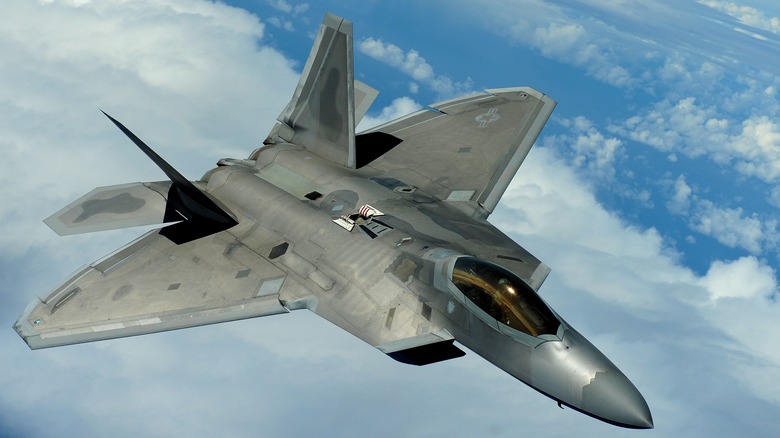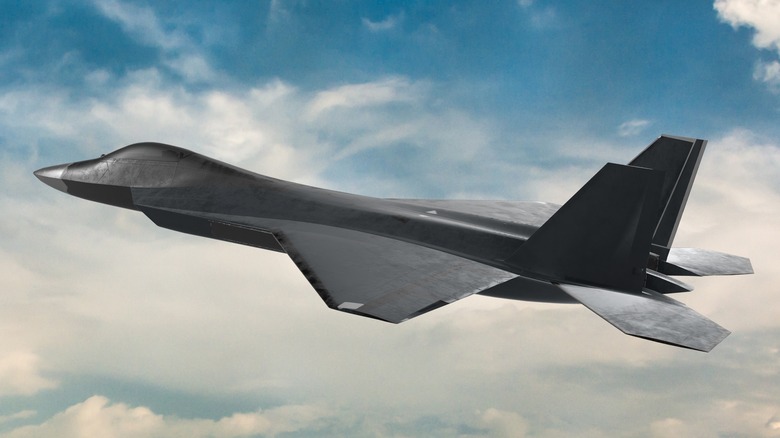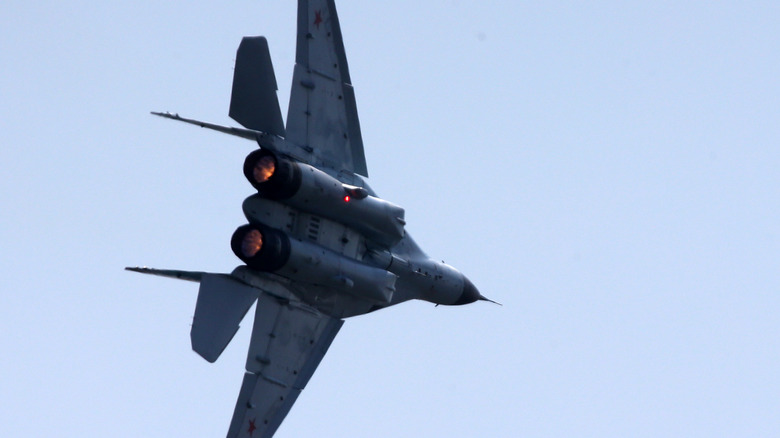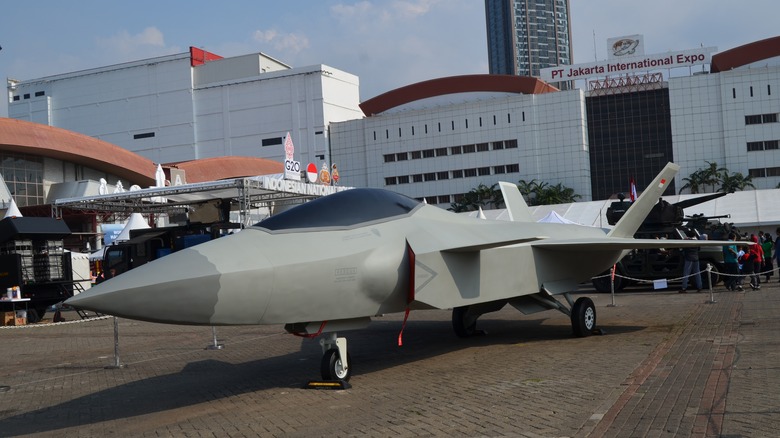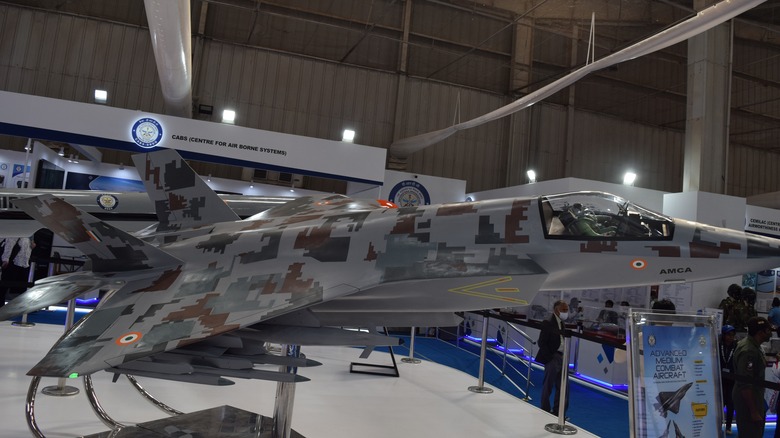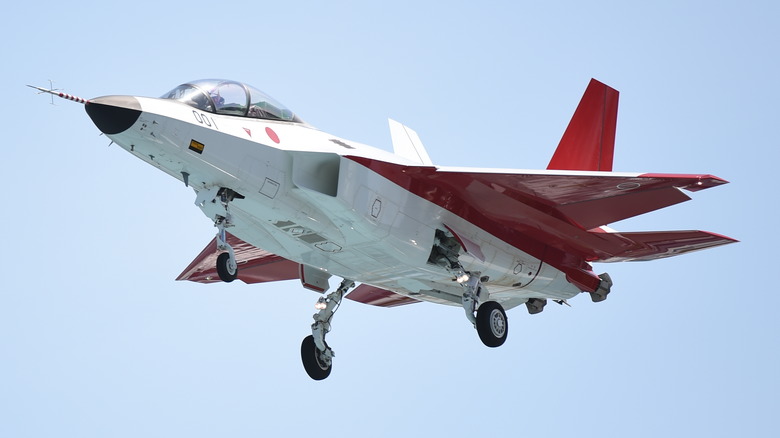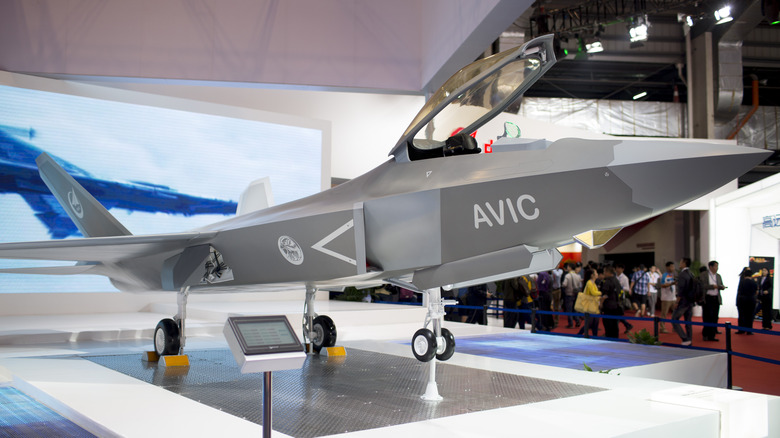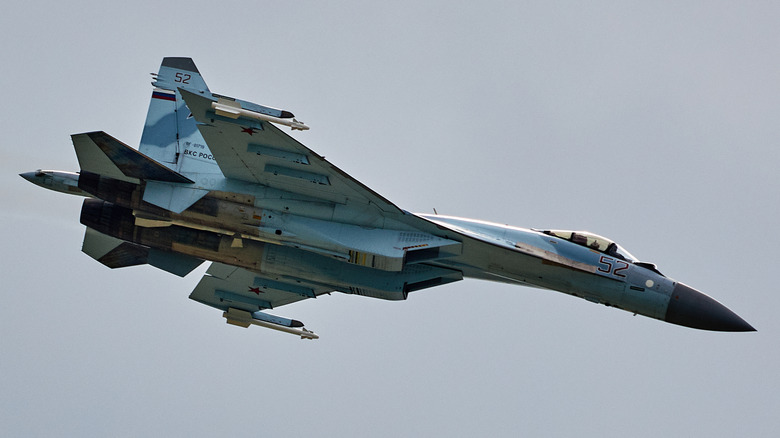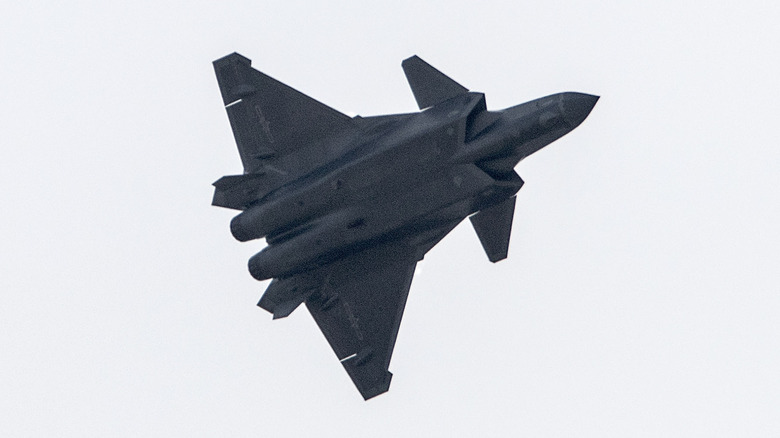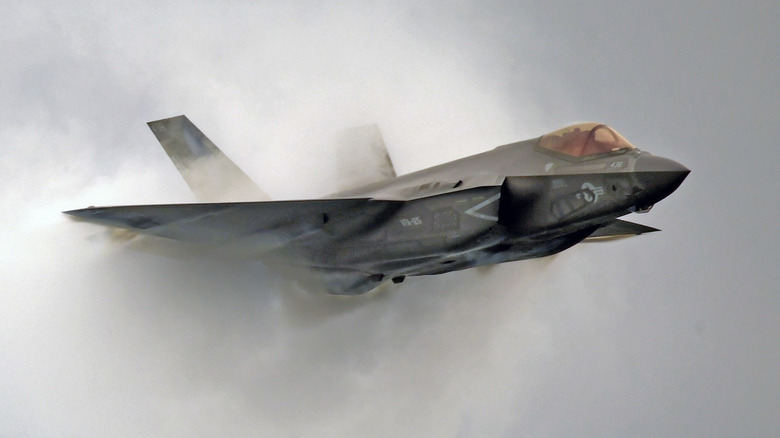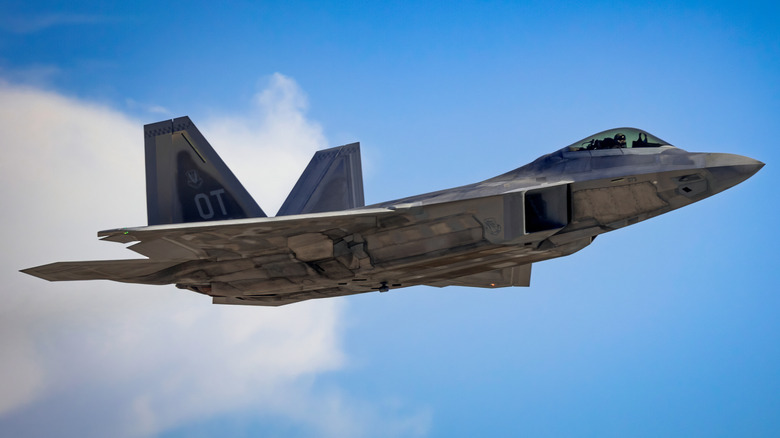10 Of The Best Stealth Jets Ever Built
In any combat space, air superiority is an important factor to establish. A force that controls the sky over a conflict zone has a huge advantage. They can stop opposing aircraft from supporting allies and attack positions with bombers or fighter aircraft. It also makes it far easier to deploy troops and transfer supplies, making developing and constructing fighter jets a critical component for any nation's military. It shouldn't be a surprise, then, that this type of aircraft can make up a significant portion of any air force, with around 30% of all the U.S. military aircraft being fighters.
When it comes to fighter jets, there are a lot of potential variants that can be employed. Some are purely attack aircraft that are designed for air-to-air combat, while others are multirole combat aircraft intended to carry out a variety of roles, such as bombing, reconnaissance, and air support. A relatively new addition to the fighter class is the stealth jet. As you'll likely have guessed, these aircraft are meant to avoid detection by making themselves invisible to sensors such as radar and sonar.
To do that, they employ a range of stealth technologies to help them carry out their missions unnoticed. Of course, some are more successful than others; here we will be looking at some of the best stealth jets that have been built to date, including some prototypes that may not have entered service yet.
TAI TF Kaan
The TAI TF Kaan is a proposed fifth-generation stealth fighter that will take on the role of an air superiority fighter that can operate in all weather and environmental conditions. Turkish Aerospace Industries and BAE Systems are collaborating to produce the fighter, which will be primarily used by the Turkish Air Force. Ground tests have already been completed and full flight tests are expected in the near future, suggesting that the TAI TF Kaan could well meet its target to enter service by 2028.
As part of the design process, the Turkish government outlined that the TAI TF Kaan would have to meet certain conditions. These included the ability to supercruise and have advanced stealth features, such as a reduced radar cross-section and internal weapon bays, as well as a composite material fuselage to disrupt radar waves. The fighter will also include a range of air-to-air and air-to-surface missiles as well as support for a number of different bombs and a top speed of Mach 1.8.
One element that could set back the project is a lack of finances, with Turkey suffering from a poor economy. However, the country's government has begun to search for third-party backers that could contribute to the development of the TAI TF Kaan, including potential partners like Azerbaijan and Pakistan.
Mikoyan MiG-41
In many respects, the Russian Aerospace Forces have lagged behind its biggest rivals – at least in terms of technology, if not in terms of sheer numbers. Russia's air forces are largely made up of aircraft such as the Mikoyan MiG-31, fighters that were first introduced in the 1970s, although even the more recent Sukhoi Su-57 lacks the performance of its American, European, and Chinese rivals. The answer to that problem is the development of the futuristic Mikoyan MiG-41 stealth fighter.
Intended as a highly advanced fifth-generation or possibly even sixth-generation fighter, the Mikoyan MiG-41 aims to take the place of Russia's main interceptor. That means it will be tasked with tracking down and destroying any opposing fighters that are seen as a potential threat. Work on the project began back in 2013, and while information about the aircraft has been scarce, there are some details that have leaked.
This includes the fact that it may well be able to reach a top speed of over Mach 4 and be able to operate at an altitude near space. That would give it a distinct advantage over any current fighter and make it the most advanced stealth aircraft on the planet. Other reports suggest it could be used to shoot down hypersonic missiles and intercept aircraft over extremely long ranges. Time will tell, though, whether the aircraft ever enters service, with some believing it may well be too good to be true.
KAI KF-21 Boramae
Although it has not yet entered service, the KAI KF-21 Boramae is a stealth fighter that has already had several prototypes created, and has had flight tests to demonstrate that its concept is sound and that it performs as expected. A joint collaboration between South Korea and Indonesia, the fighter is planned to begin active service in 2026 and be available to export to external countries.
This new fighter will replace the F-4 Phantoms and F-5 Tigers that make up the vast majority of South Korea's air forces. Specs suggest it will be able to reach speeds of Mach 1.81 and have a range of 620 miles. The first iteration of the fighter will be intended for air-to-air combat, with a future second model more of a multirole fighter that can also conduct ground strikes. The KAI KF-21 Boramae will also be able to pack a strong punch, thanks to its 20mm M61A2 Vulcan rotary autocannon and range of missiles and bombs.
Originally intended to act as a full stealth fighter, the KAI KF-21 Boramae has limited stealth capabilities compared to the likes of the F-35 Lightning II and F-22 Raptor. This is the result of several factors, including a larger cross-section and externally mounted weapons. Yet it is capable of outperforming almost any other fourth-generation fighter and will be harder to track with radar than most other aircraft, due to its use of radar-absorbent material, a curved design, and S-duct engines that are easier to hide from radar.
HAL AMCA
Like other Asian countries, India is determined not to be left behind as China develops its new generation of aircraft, including the Shenyang FC-31. In the face of further Chinese expansion and increased military tensions in the region, nations are looking to update their air forces to help defend their interests. In India, that means working on an upgraded stealth fighter that is capable of taking part in a variety of missions, such as air-to-air combat, ground and maritime strikes, and aerial bombing.
The HAL AMCA is a fifth-generation stealth fighter that will operate as part of the Indian Air Force and Indian Navy. Development costs for the project, which will also incorporate some sixth-generation fighter technology, are expected to be around $2 billion; working prototypes could be ready within the next three years.
As India's first fifth-generation fighter, the HAL AMCA will use advanced technology that includes an ability to supercruise — that is, travel faster than the speed of sound without the use of afterburners — and support for directed energy weapons. An internal weapons bay and S-duct engines will help hide the fighter from radar, while a twin-tail layout and composite materials are designed to reduce the cross-section and absorb radar waves.
Mitsubishi F-X
The rapid development of China's Shenyang FC-31 has led to a number of neighboring powers looking to expand their air forces with fifth-generation stealth fighters capable of countering that aircraft. Japan is one such nation and the Japan Air Self-Defense Force is currently working on a sixth-generation stealth fighter known as the Mitsubishi F-X in collaboration with Mitsubishi Heavy Industries. It is intended to enter service in the 2030s and will replace the Mitsubishi F-2, a fourth-generation fighter that is derived from the F-16 Fighting Falcon.
Little is known about the capabilities of the new aircraft but it is heavily influenced by the Mitsubishi X-2 Shinshin, an experiential prototype that was developed between 2009 and 2016 and acted as Japan's first stealth fighter. This new model would include a microwave weapon to tackle incoming missiles alongside new ASM-3 supersonic missiles. The stealth fighter is also designed to work in tandem with a loyal wingman drone that can help locate targets, perform reconnaissance, and even direct fire away from the aircraft.
Much of the development of the Mitsubishi F-X has been done in consultation with the U.S., a strong ally of Japan. The two countries often conduct joint military drills and the Mitsubishi F-X is being designed to be interoperable with U.S. forces so that it can easily share data and be part of joint missions. In 2023, the Japanese government signed a treaty with the U.K. and Italy to develop a new fighter jointly, sharing information and technology between the three nations. A prototype is due to be manufactured in 2024, with test flights scheduled to follow in 2028.
Shenyang FC-31
Also known as the J-31, the Shenyang FC-31 is a stealth fighter that is still in development but has been tested multiple times since its first flight in 2012. From what has been shown of the stealth fighter so far, it appears to be fitted with two Russian-made RD-93 afterburning turbofan engines, and designed to tackle multiple roles. It will also be able to launch from aircraft carriers.
There have been claims that the Chinese fighter has been built using stolen technology, with different elements of the aircraft closely resembling both the F-35 Lightning II and F-22 Raptor. This was seemingly backed up by a Congressional report called the U.S.-China Economic and Security Review Commission, which found that details and design specs from those fighters had been acquired from illegal cyber-attacks.
Like many other stealth fighters, the Shenyang FC-31 uses a range of stealth technologies to keep it hidden from radar. This includes a reduced cross-section and curved surfaces to help scatter radar waves, as well as radar-absorbent material that can absorb much of the energy of waves hitting the aircraft so they cannot bounce back to give away the plane's position. The fact that it is not currently in service means little is known about its other capabilities, although it is believed to be able to reach speeds of up to Mach 1.8 and carry a large payload that includes up to eight tons of weapons.
Sukhoi Su-57
The Sukhoi Su-57 is Russia's current answer to the U.S. stealth fighters such as the F-35 Lightning II and F-22 Raptor. It is a multirole aircraft that can be used in a diverse range of missions and carry out an array of objectives. The fighter, developed by Sukhoi, first entered production in 2019 and around three dozen aircraft have been delivered into service with the Russian Aerospace Forces.
The Sukhoi Su-57 comes in several variants that expand its use in aerial warfare, allowing it not only to establish air superiority but also to strike both ground and maritime targets in a variety of conditions and environments. Russia plans to eventually replace its current stock of MiG-29 and Su-27 aircraft with the Sukhoi Su-57 and other in-development aircraft that incorporate stealth technology to match the current capabilities of U.S., European, and Chinese air forces.
The performance of the Sukhoi Su-57 in battle is still not known, with the fighter not thought to have been used in Russia's invasion of Ukraine. From what is known about the aircraft, it seems able to reach speeds of up to Mach two — twice the speed of sound — and has the ability to outcompete most fourth-generation fighters. However, its stealth capabilities and computing powers are believed to be much reduced compared to its main rivals, using basic techniques such as aircraft shaping to hide from radars. Yet, it does have significant armament, coming equipped with air-to-air missiles, air-to-surface missiles, and a single-barrel 30 mm cannon.
Chengdu J-20
Among the limited number of stealth fighters that exist in the world today, the Chengdu J-20 is counted as one of the best. Nicknamed the Mighty Dragon, it is a single-seat twin-jet fighter that is designed to be used at night and in all weather conditions, regardless of visibility. Until the last few years, the world of stealth fighters had been dominated entirely by the U.S., who is responsible for designing and developing all of the in-production models in the world — although several countries have purchased units such as the F-35 Lightning II.
Bearing a striking resemblance to the F-22 Raptor, the Chengdu J-20 actually shares more in common with the F-35 Lightning II as a fighter that is intended to establish air superiority and carry out precision strikes on the ground. With production beginning in 2009, the first aircraft began active service in 2017, and estimates suggest there are now in excess of 200 Chengdu J-20 fighters in the People's Liberation Army Air Force.
The Chinese aircraft can carry up to four beyond-visual-range missiles, although it doesn't have a close-range gun like the F-22 Raptor's 20mm Gatling gun. However, analysts suggest it has a higher range and faster top speed than many other stealth fighters. In terms of stealth, it has a similar profile to the F-22 Raptor and uses a similar approach to hiding from detection, with a reduced radar cross-section.
Lockheed Martin F-35 Lightning II
In many ways, the Lockheed Martin F-35 Lightning II is the successor to the F-22 Raptor. The main difference between them is that the F-35 was designed as a multirole combat aircraft from conception, while the F-22 was always envisioned mainly as an air-to-air fighter. While there is certainly room to debate which is the more effective fighter, there's little arguing that the F-35 Lightning II has been an unprecedented success, with more than 1,000 units produced since the aircraft first entered service in 2015 and many more planned for the future.
One of the most advanced fighter jets in the world, the stealth capabilities of the F-35 Lightning II are incredible, if not quite at the level of the F-22. But it is far more flexible than the F-22 and is capable of carrying out more mission objectives. A big reason for this is the computing power of the aircraft, which provides the pilot and other military units with a huge degree of situational awareness as it flies overhead. That's why it has been exported to a number of U.S. allies, including the U.K., France, and South Korea.
The F-35 Lightning II also has another major advantage over its F-22 cousin in that it is significantly cheaper to both produce and service. This is largely down to the fact that is has just a single jet engine, making it easier and quicker to fix. Of course, this also comes at a cost: The F-35 Lightning II's lower engine output means it carries a reduced payload and can't perform at the same heights.
Lockheed Martin F-22 Raptor
Primarily developed as an air superiority fighter — which means it is designed to dominate the skies and eliminate enemy fighters over a conflict zone — the Lockheed Martin F-22 Raptor has proven itself as a capable multirole fighter that can carry out a number of missions. A joint collaboration between Lockheed Martin Aeronautics and Boeing Defense, Space & Security, the F-22 Raptor was first tested in 1997 before entering full service in 2005, continuing its role in the United States Air Force to this day.
Touted as the first fifth-generation fighter and the first to include stealth technology as standard, the F-22 has demonstrated on multiple occasions that it is one of the most advanced and successful stealth fighters on the planet. Despite a relatively small number of aircraft being produced, the fighter has a track record that suggests it is a cornerstone of the United States Air Force and has a distinct edge against any other fighter it might come up against.
A compromise between aerodynamics and stealth, the aircraft has supermaneuverability, integrated avionics, and a powerful weapons platform that is largely unmatched by other similar aircraft. Its shape and design ensure that radar beams are scattered when they hit the curved surface, and the various tailfins and edges are all intended to make it look smaller or hide antennas that are easier to spot by detection systems. The F-22 Raptor is even capable of sneaking up on enemy fighters and flying directly underneath them completely undetected.
